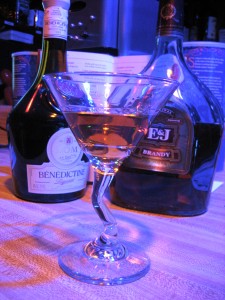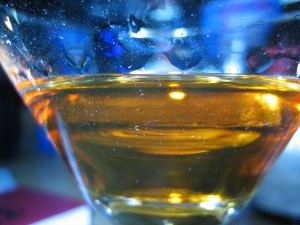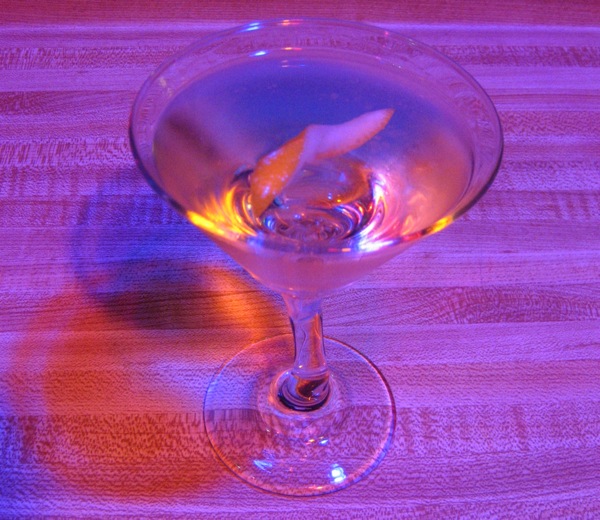Posted: October 7th, 2009 | Author: blake | Filed under: Cocktail Corner | Tags: Benedictine, Brandy, floating | No Comments »
Ok so one of the ‘B’s is for “Benedictine” and the other is for “Brandy.” Â According to Mr. Boston’s bartending guide a B & B should be 1/2 oz of the one ‘B’ and 1/2 oz of the other. Â Mr. Boston says you should pour the Benedictine first, into a cordial glass, which is one of those glasses that looks like a tiny red-wine glass, and then float the brandy on top.

figure 1: this has gone terribly wrong
My first problem was that I could not find a cordial glass. Â I am not sure we even have any. Â It does not help that about 2/3 of our bar glassware is currently all packed up in the basement. Â But so anyway first I fetched a sherry glass, which is like if you took a red wine glass and made it more narrow but left the vertical dimensions untouched. Â I got as far as pouring the Benedictine in before I realized I was going to have a lot of trouble floating the brandy due to the fact that there was about three inches of glass between the top surface of the Benedictine and the rim of the glass. Â So I went and fetched this sort of like child sized cocktail glass (what some of you barbarians refer to as a martini glass). Â Well that got the top of the liquid closer to the rim of the glass but I was using this really narrow jigger to measure out the brandy and it started spilling all over the bar while I was trying
to pour it over the hello kitty spoon and then some dinosaurs blew up the earth etc. etc. and so I just poured the brandy in and it got all mixed up. Â See [figure 1] to the right.
So anyway despite the lack of liquor separation in the glass, and the fact that the glass is all wrong, and the dinosaur guts all over the place, this cocktail proved to be quite delightful. Â The brandy cuts the strong anise-y flavour of the Benedictine and draws out the more subtle flavours. Â I detected a flavor that reminded me strongly of Turkish chai, which was this stuff we drank when I lived in Turkey that I think was actually just instant tea because I remember it being oddly shaped dry crumbly bits that you mixed in with hot water and then viola! Â Chai! Â Not at all like what they call “chai” at the hipster coffee houses. Â Anyway. Â The flavour was sort of grassy, in the end.

figure 2: look at the exciting brown on brown layers!
Ok and but so one ounce of cocktail is not all that much and pretty soon that was gone and I got it into my head that I should really make more of an effort to try floating the brandy. Â So I did basically the same things except instead of pouring straight from the jigger I poured the measured amount of brandy from the jigger into a shot glass, which I reasoned held a larger volume of liquid and would therefore allow me to pour it from a more reasonable angle. Â It didn’t really work out; the brandy clung to the outside of the shot glass and trailed all the way down and trickled off the bottom. Â That was ok, though, because I could still pour it in a semi-controled fashion and I managed to successfully float the brandy. Â See [figure 2]:
But the flavour?! Â Brandy. Â Of course. Â It tasted just like brandy at first because thats all you get when you sip a drink like that. Â Maybe it works different if you have a real cordial glass but anyway I got sick of it pretty quick and swished the glass around a few times to mix the two liquids together.
And so but that one went down pretty quick too and so when it came time to mix the third I decided to do some science on this drink. Â I formed the following hypothesis: Â I will enjoy this drink even more in a lowball glass over some ice, and also with larger volumes. Â So I mixed a whole shot of each ‘B’ in a lowball glass over three frozen cubes of distilled water (science!). Â Then I realized my methods were highly questionable as I had no way of providing a control for this experiment. Â So all I can give you is qualitative, anecdotal observations that this is a good drink over ice, but you do loose some of the subtle flavours. Â Also somehow the brandy comes through more strongly although this could be because I had given up on trying to float anything so I did not spill a bunch of the brandy on the bar.
Posted: September 1st, 2009 | Author: blake | Filed under: Cocktail Corner | Tags: gin, orange bitters, prohibition, vermouth | No Comments »

So here I was thinking to myself that it’s time to try something new. Some kind of drink I’ve never had before. Maybe something with that Benedictine I’d made a fuss about acquiring and then never used aside from taste testing it against the Chartreuses (I think it tastes more like the yellow than the green, but I neglected to write down those results so probably the tests will have to be repeated at some point in the future). So I get out our copy of the 2009 edition of Mr. Boston: Â Official Bartender’s Guide. Â Actually it was already sitting on the bar, but I’m going to call the act of picking it up getting it out. Â Usually with these things, these bartender guides and books of cocktail recipes, I just flip through them until I find a drink that looks palatable but new; or on some nights, I meticulously craft which ever drinks are possible considering available ingredients in sequential order as they appear in the book. Â Generally that’s how I end up with a drink with raw egg in it.
So this time I was after something that contained Benedictine. Â I open up Mr. Boston, and this time I start in the very front for some reason, probably because it’s a pretty new book and in good shape and it seems like the respectful thing to do to a book, open it up to the beginning, and it’s got all the little tables and drawings and instructions on how to muddle, how to shake, and that stuff is always so much fun to read so I get side-tracked and start reading about like how if I have four people at a dinner party I should have two 750 ml bottles of wine or just one 1.5 liter bottle (I guess the chart got more complicated later on) and how there is a special muddling tool you can buy that is made of wood and then at the end of all this there is a chapter titled “Cocktail Classics.” Â The chapter starts out with the Old-Fashioned Whiskey Cocktail. Â I start turning pages. Â Next is the Manhattan. Â I’m drawn in by the opening line, “A hundred years after the Old-Fashioned, near the end of the 1800’s, we find the Manhattan.” Â Really that should have made me go back and read about the Old-Fashioned, but I was intrigued. Â I had always thought the Martini was the first cocktail, and that it was a product of the San Francisco gold rush, putting it’s origin somewhere after 1849, right? Anyway, next page: Â the Martini Cocktail.
Mr. Boston does not agree with my San Francisco gold rush story at all. Â Instead, he claims the Martini is some kind of better looking brother of the older drink: Â the Martinez, sort of like Micky vs. Mortimer. Â Except I think most of us probably knew about Mortimer. Â The “Martinez” shows up in “The Bar-Tender’s Guide” from 1887 and calls for:
Martinez Cocktail
- 1 dash of Boker’s bitters
- 2 dashes of Maraschino
- 1 pony of Old Tom gin
- 1 wine-glass of vermouth
- 2 small lumps of ice
Boker’s is apparently like angostura. Â Old Tom, some kind of sweetened gin which is no longer produced by anyone. Â Mr. Boston helpfully explains to us that 1 wine-glass means two ounces. Â However, we are left on our own to decide what 1 pony means. Â Or Google, I suppose. Â Apparently a pony is an ounce.
Anyway that’s not the one I ended up making. Â This is what I made:
Martini Cocktail (dry)
- 1 ounce Gin
- 1 ounce Dry Vermouth
- 1 dash Orange Bitters
Stir with ice, strain into a cocktail glass, garnish with a twist of lemon.
There is also a recipe for a sweet martini, which calls for sweet vermouth instead of dry. Â The book claims that the term “dry martini” used to simply mean use dry vermouth instead of sweet, and it was during and after prohibition when a whole lot of newbies we manning the bar when “dry” came to mean “less” in terms of Vermouth, and Vermouth came to mean Dry Vermouth. Â I have no idea what happened to the bitters. Â I’ve never heard of putting bitters in a Martini. Â Not a proper Martini, at least, as in a drink made of gin and Vermouth, as opposed to the contemporary definition of “Martini” as a synonym for “cocktail.” Â So I made it. Â I even stirred and strained instead of putting it into the shaker.
At this point in writing this post I have finished the first cocktail and have had to go and make another. Â I’m using Bombay Sapphire, Martini & Rossi extra dry Vermouth, and Stirrings Blood Orange Bitters. Â For this second drink I halved the amount of Vermouth as that first drink did seem a bit Vermouth-y. Â I am kind of regretting that decision. Â The gin stands out way more in this second drink, but there is still the aftertaste of Vermouth. Â Now I love gin, and am usually happy to be sipping on a glass of straight Bombay Sapphire, Hendricks, or Juniper, but with these proportions it seems more like the Gin and Vermouth are fighting each other, each trying to punch through. Â With equal proportions the drink was very smooth, with more white wine flavours than gin flavours. Â For what I think of as a Martini, it was rather sweet, akin perhaps to drinking a fortified white wine.
I do like the addition of orange bitters. Â And the twist of lemon is my preferred Martini garnish. Â I’ve been experimenting with increasing the ratio of Vermouth to Gin in my Martini’s anyway, though 1:1 still seems laughably high. Â Would I give up my more standard Martini composed of two ounces of gin, a half capful of Vermouth, and a twist of lemon for this? Â No, but I think it is worth trying.
I think it helps to have relatively fresh Vermouth. Â I usually buy the smallest bottle possible. Â It is tempting to get the giant bottle for $6 instead of the 375 ml bottle for $4, but it is a wine of sorts and I don’t trust it to stay shelf stable after opening in the same way I trust a scotch or a vodka.




Recent Comments